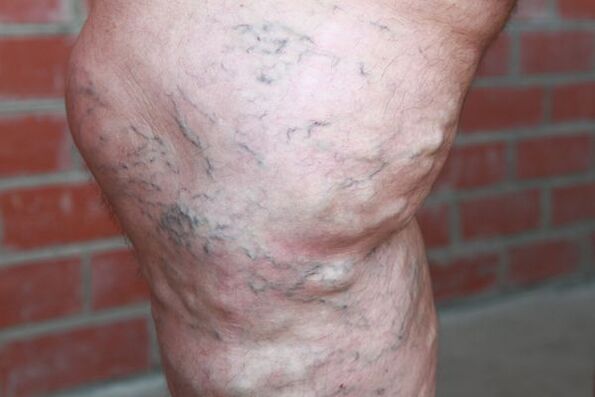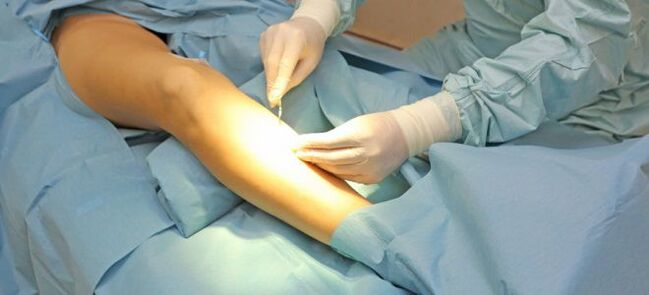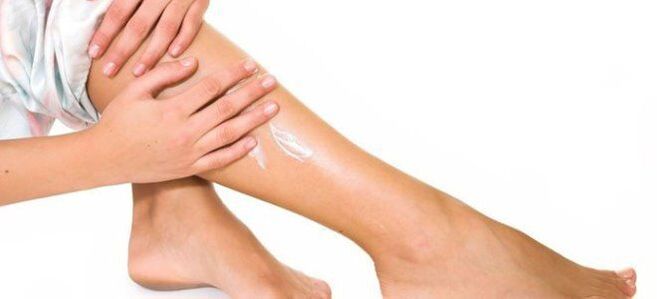Varicose veins manifest as the veins stretch and grow in size, they gain blue-violet or red shades, due to the accumulation of a large amount of blood.Varicosis is a widespread disease and in most cases manifests itself in the feet, but at the same time it can also be formed in other parts of the body.

For most people, especially for women, varicose veins, first of all, is an aesthetic problem.In the early stages, the disease does not pose a threat to health.Ugly swinging veins can disrupt the appearance of individual parts of the body, but if you do not pay attention to the treatment and prevention of varicose veins, complications can develop over time.
The causes of varicose veins
A number of factors can increase the risk of varicose veins:
- Hereditary predisposition.If someone from your family suffers from varicose veins, you have all the chances of inheriting the disease.
- floor.According to statistics, varicose veins are more common in women than in men.
- Age.With age, veins and valves become weaker, and there is a possibility of developing varicose veins.
- Violation of blood flow between arteries and veins.
- Hormonal changes.This is especially true for the pregnancy period, premenstrual period and menopause, when hormonal changes occur.In these periods, the risk of varicose veins increases.During pregnancy, the growing fruits press in the veins in the legs.In this case, any subsequent pregnancy increases the risk of varicose veins.
- Thickening.Due to the excess weight in the vein, the very high pressure is very large, which can provoke the appearance of vaaricosis.
- Work of "sedentary" and "standing" and a lifestyle sitting.If you have to stay or sit for a long time, the risk of varicose veins increases.This is because during a long stay without movement, the veins are more difficult to give blood to the heart.
The main symptoms of varicose veins
In addition to the characteristic formation of elongated dark blue or purple veins, these are the main signs of varicose veins development:
- Little ellinge of the legs and legs, especially after a long standing standing.
- Pain, burning and severe feeling in the legs.
- Foot spasm and pulse.
- Itching in the ankle area and lower legs, which are often mistakenly diagnosed as dry skin.
- Change in skin color in the development of varicose veins (the appearance of bruises).
Treatment of varicose veins of lower extremities
To effectively fight the problem of varicose veins, you need an integrated approach, which includes:
- Drugs for the treatment of varicose veins - tablets, capsules and dots;
- Local funds - creams, ointments and gel;
- Compression therapy;
- The right lifestyle;
- Moderate physical activity;
- Savings and surgery methods (Laser abtvia, sclerotherapy).
Compression therapy
When the first symptoms of varicose veins appear, it is recommended to start wearing compression clothing - socks, tights or leggings create slight pressure from the bottom of the legs, reducing blood accumulation and reducing edema.It is necessary to wear such compression clothing constantly, only in this case can you achieve a positive effect.Wearing compression clothing will not cure existing varicose veins, but will help prevent or reduce the growth of veins and further complications.
Savings and surgical treatment methods
Laser -rich ablation (radiator or laser)
The method of endodenous laser ablation is today the most effective and safest way to treat varicose veins.The use of laser or radio -radio therapy, with which varicose veins are closed or removed.The doctor makes a small cut on the skin near the vein and inserts a catheter into it, then a special device is connected to the top of the catheter, by which the catheter heats up and closes or removes the varicose vein (depending on the selected method of ablation).The procedure is performed using local anesthesia and the patient, as a rule, returns home the same day.
Sclerotherapy
Sclerotherapy refers to saving varicose vein treatment methods.During the procedure, a special substance is inserted into the veins affected by varicose veins, which destroys the inner shell of the vein and causes the blood to be coagulated within it.After some time, Vienna has been destroyed and disappeared.
Surgical
In advanced cases of varicose veins, some, especially saving treatment methods, are no longer effective.In this case, the patient suffering from varicose veins can help, during which the superficial vein is surgically removed.Indications for surgery are ulcers, bleeding, phlebitis.The surgery is performed under general anesthesia, as a rule, the patient goes home the same day.Within 2 weeks after surgery, pain and discomfort can be observed, this is normal.

Physical activity and way of living
Training for varicose veins
Many moving and training is a lot of main allies in the fight against varicose veins.Not all training is just as useful, and some can even harm a person suffering from varicose veins.
Moderate rhythmic physical activity, such as walking prevents the progression of the disease and the development of complications, as dynamic muscle movements help guide blood from the periphery to the heart.
Walking is perfect for preventing varicose veins, this type of physical activity contributes to a healthy blood circulation by stretching and reducing the venous pump in the calf muscles.Walking at least 30 minutes at least 5 times a week.
Jogging
Running at a low pace includes the calf muscles, but there is a barrier - running our joints.If you are not willing to replace the direction with a different type of activity - execute along the grass or rubber trails, and not along the strong asphalt.
Elliptical and exercise bike
Training for an elliptical imitator and bike exercise actively involves the calf muscles, this contributes to normal blood circulation.
Electrical construction
Patients with varicose veins should avoid a large number of very intense training with weights, gatherings, lungs and twisting.All of them adversely affect the course of the disease and contribute to its further development.During prolonged muscle tension, blood accumulates in the veins of the legs, blood circulation worsens, all of which provokes the development of complications.When training strength and after completing them, it is recommended to wear compression socks.
The most effective medicines for the treatment of varicose veins
Today, pharmacies present a wide range of medicines for the treatment of varicose veins in the form of tablets, drops, ointments, creams, gels.
The main groups of medicines used to treat varicose veins
For the treatment of varicose veins, several groups are used: ointments, creams, tablets, less often injection solutions.
Characterization of each of these groups:
- Snapper.Thrombosis prevents, reduces the adhesion of platelets and red blood cells and their ability to adhere to the vascular endothelium.Reduce the surface tension of the red blood cell membranes, facilitate their deformation when going through the capillaries and improve blood flow.
- Flimetry.They act on improving the venous exit.
- Venotonic.Help to normalize the filling of blood vessels with blood.
- Anticoagulants.Change blood viscosity.
- Nonsteroidal anti -inflammatory drugs.They have an analgesic and anti -inflammatory effect, used to eliminate the pain.
- Fibrinolytic.Reduce the risk of developing vein thrombosis.
- Antioxidants.They have a vasoculatory effect.
Flimetry
To solve the problem, it is necessary to increase the tone of the veins.Therefore, patients with varicose veins are prescribed phlebotonic (venotonics).The main task of veneone -property drugs is to strengthen weak blood vessels and normalize blood circulation.
Flebotonics varies in the composition and range of prices, therefore, for the treatment of varicose veins, you can find the most suitable version of the medicine in terms of cost.
Phlebotonics containing a diosmin
Diosmina refers to representatives of bioflavonoids and is found in many medicines to combat varicose veins.It has venotonic effects, improves lymphatic drainage, improves microcirculation, reduces leukocyte adhesion to the venous wall and migrating them to pawenozoic tissue, improves diffusion and oxygen perfusion in the skin tissue, and has an anti -inflammatory effect.Blocks the production of free radicals, prostaglandin synthesis and thromboxan.
Experimental studies have shown that Diosmia twice accelerates lymph exit, increases the tone of the venous wall, inhibits leukocyte activity and prevents inflammatory processes.
Snapper
This is a group of medicines that affect the blood coagulation system, preventing the adhesion of uniform elements, platelet plaques.Antiplans is another name for the drugs of this group, as, in fact, natural or synthetic substances block platelet adhesion and suppress the formation of blood clots, which is often needed in the treatment of varicose veins of the lower extremities.
Antioxidants
Antioxidants are substances that inhibit the peroxidation of lipids and proteins as part of the cell membrane, bind free radicals and thereby slow down the processes of oxidation and aging.Preparations of this group can be described in the complex treatment of varicose veins.They help to improve the extension and elasticity of the blood vessel walls, strengthen them and extend the normal life of each cell of the walls even smaller veins.
Anti -reductional medicine
Often varicose veins are associated with pain and swelling.To restore softness in the leg, decongestant medication is often prescribed in the complex treatment of varicose veins.They improve the flow of lymph from the affected areas, remove excess fluid from the body.
Which doctor is treating varicose veins?
As a rule, a phlebologist is engaged in the diagnosis and treatment of varicose veins.Unfortunately, not in all medical institutions you can find a doctor of this specialty.It should be borne in mind that some close experts are also able to help treat varicose veins - this is an angiologist and vascular surgeon.The therapist can also help diagnose the disease and the patient's direction to the relevant close specialist.
Remember that in the early stages of the disease, pronounced clinical manifestations are usually absent.Therefore, in case of suspicion of varicose veins, it is necessary to contact a qualified specialist immediately who will make a diagnosis.As a rule, the diagnosis of varicose veins is performed taking into account the patient's complaints, the examination of the lower extremities, as well as the data of laboratory and instrumental search methods.It is possible to verify the development of the disease and take measures in time to prevent it only after a careful examination of the patient.
External products for treating varicose veins

All modern ointments are prescribed in addition to the main treatment of varicose veins with medication.Local treatment helps to achieve a comprehensive effect on the problem.
It is recommended to use creams, gel and ointments in complex treatment as well as for preventive purposes.Especially for people who have a genetic predisposition to varicose veins.In any case, when the first symptoms occur, urgent measures must be taken.Otherwise, the disease can develop and cause severe discomfort.
Local varicose vein treatment is an important therapeutic agent, which, along with the treatment of medicines, physiotherapy and prevention, helps return a healthy circulatory system:
- Heparin -based ointments are used in the complex treatment of varicose veins, along with tablet medicines.Ointment is applied to the affected areas of the skin.Heparin acting substance is absorbed and has a therapeutic effect, the acting substance strengthens the walls of veins and capillaries, improves blood resorption limited to the micrombach.
- Plant extracts, especially horse chestnut, show such heparin action, and in addition, stimulate regeneration processes and improve the condition of the skin.Ointments created on the basis of plant extracts affect the metabolism of the skin and blood vessels, have a multifaceted effect, indicate a regenerative effect, improve the appearance of the skin and blood vessels.
- Non -inflammatory drugs non -inflammatory in addition to removing pain and inflammation, relieve the general condition of patients with varicose veins, affect the processes of restoration in the body.External use of medication does not reduce their effectiveness, allows you to affect injured points in the country.
The use of ointments for the treatment of varicose veins is regulated by a phlebologist that takes into account the indications and contraindications for their use.Therefore, despite the simplicity of such a medicine, using it independently, without consulting with a doctor, is unacceptable.
Ointments based on heparin
Ointments for the treatment and prevention of varicose veins based on heparin are produced under different names, they vary from one another in the presence of the excipients that modify the action and effects manifested, and also have different manufacturers.
Heparin is a unique substance, so it is part of many medicines for the treatment and prevention of varicose veins.What the oil to choose in order to treat the varicose veins in the legs will tell the doctor.In addition to ointments based on heparin, there are herbal preparations, which no less effectively prevent the development of varicose veins.
Local drugs with venotonic and blood flow effects
Ointments plant components are complex natural substances that vote comprehensively with varicose veins, strengthen the blood vessel walls and improve blood circulation.
To relieve pain and inflammation for varicose veins, non -steroidal anti -inflammatory drugs can be used.Oints based on NSAIDs relieve the patient's overall condition with varicose veins and allow to accelerate recovery processes.
How do the oil, cream and gel differ from each other?
There are no significant differences between external medicines in the form of oil, gel or cream, however, ointments and creams are made based on fat or animal fats, and the actual ingredients in them are not completely dissolved.
Gels are produced on a water base, therefore all the active ingredients in them are completely dissolved, without residues, which contributes to faster penetration and absorption into the skin.
External products for the treatment of varicose veins should always be applied to clean skin.They should be used regularly, especially in severe forms of the disease.Remember, varicose veins are not a simple disease and here is needed an integrated approach.Specialized, non -meditic consultation is required.Only after making a diagnosis will the doctor be able to prescribe treatment, which includes medicines for internal and external use.In this case, a patient with varicose veins should lead a healthy lifestyle.























